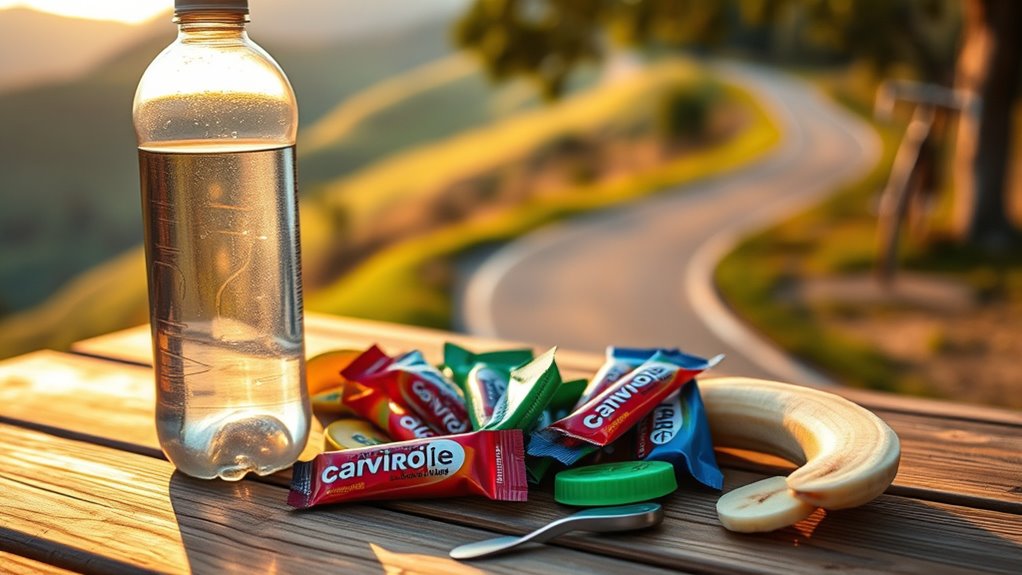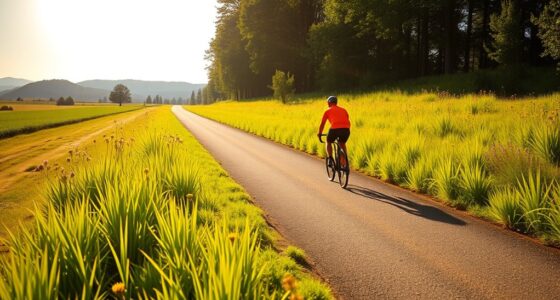For long rides, focus on fueling with carbs like bananas, energy gels, and grains to maintain energy levels, and include proteins and healthy fats for sustained effort. Eat a balanced meal 2-3 hours before riding, then snack every 30-45 minutes with quick-to-digest foods during your ride. Stay hydrated with water and electrolyte drinks, adjusting intake based on conditions. To master your nutrition plan and optimize performance, keep exploring more essential tips.
Key Takeaways
- Consume a balanced meal with carbs and protein 2–3 hours before riding for sustained energy.
- Eat small, carbohydrate-rich snacks every 30–45 minutes during the ride to maintain blood sugar levels.
- Hydrate regularly with water and electrolyte drinks to prevent dehydration and cramps.
- Incorporate quick energy foods like energy gels, bananas, or trail mix for easy digestion during the ride.
- Post-ride, focus on protein and carbs to support muscle recovery and replenish glycogen stores.
Understanding Your Energy Needs for Extended Cycling
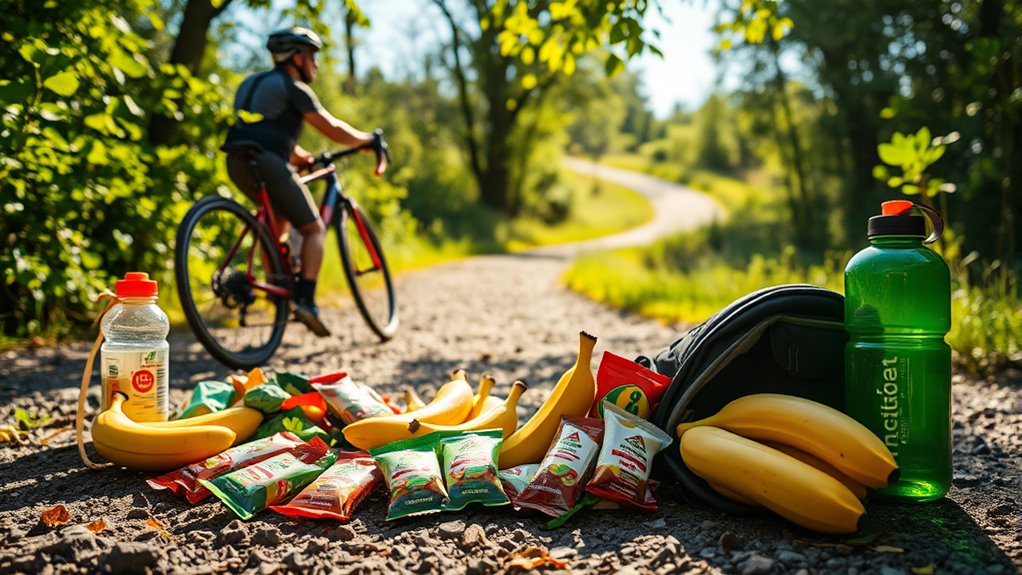
Understanding how much energy you need is essential before hitting the road for a long ride. By calorie counting, you get a clear picture of how many calories your body requires to sustain your effort. This helps you plan your meals effectively, ensuring you have enough fuel without overloading. Moreover, knowing your metabolic rate can further refine your calorie estimates and improve your nutrition strategy. Additionally, high-quality projectors can improve your visual experience when reviewing maps or navigating routes during your ride. Staying aware of data privacy challenges is also important when using digital tools to track your nutrition and route data. Proper planning prevents energy dips and keeps you steady on your journey. Knowing your energy requirements helps you stay fueled, focused, and comfortable throughout your long ride.
Key Nutrients to Focus On During Long Rides

During long rides, focusing on key nutrients helps you maintain energy levels and prevent fatigue. Prioritize carbohydrates, which are your main energy source, and incorporate proteins for muscle repair. Healthy fats also provide sustained fuel, especially during extended efforts. Using a reliable electric bike conversion kit can assist in covering longer distances with less fatigue, allowing you to focus more on nutrition and performance. Calorie counting is essential; it guarantees you’re fueling adequately without overeating. Meal planning simplifies this process, allowing you to carry the right foods at the right times. Including a variety of nutrient-dense foods ensures you get a broad spectrum of essential vitamins and minerals needed for sustained energy. Include easily digestible snacks like energy gels, bananas, or trail mix to keep your energy consistent. The cost of electric bikes varies widely, so choosing one that matches your riding needs and budget can help you extend your rides comfortably.
Hydration is equally important—water and electrolyte drinks help prevent dehydration and cramping. By concentrating on these nutrients and planning your meals, you’ll stay energized and perform your best throughout your long ride.
Optimal Timing for Eating Before and During Your Ride

Eating at the right times can considerably boost your energy and endurance on long rides. Your meal timing and fueling schedule are vital for maintaining steady energy levels. Aim to eat a balanced meal 2–3 hours before starting, giving your body time to digest. This pre-ride meal should include carbs and some protein. During your ride, follow a fueling schedule of small, frequent snacks—about every 30-45 minutes—to prevent energy dips. Don’t wait until you’re hungry to refuel; proactive eating keeps your blood sugar stable. Hydration is also key, so drink water regularly. Incorporating nutrient timing strategies can further optimize your performance. Adjust your timing based on ride intensity and duration, but always prioritize consistent nourishment to sustain your performance from start to finish. Recognizing the importance of energy management helps you plan your intake more effectively throughout your ride. Additionally, understanding juice cleansing benefits can inform your hydration choices and support recovery after long rides. Being mindful of proper hydration is essential for maintaining electrolyte balance and avoiding dehydration during extended periods of exertion.
Best Food Choices for Sustained Energy and Recovery
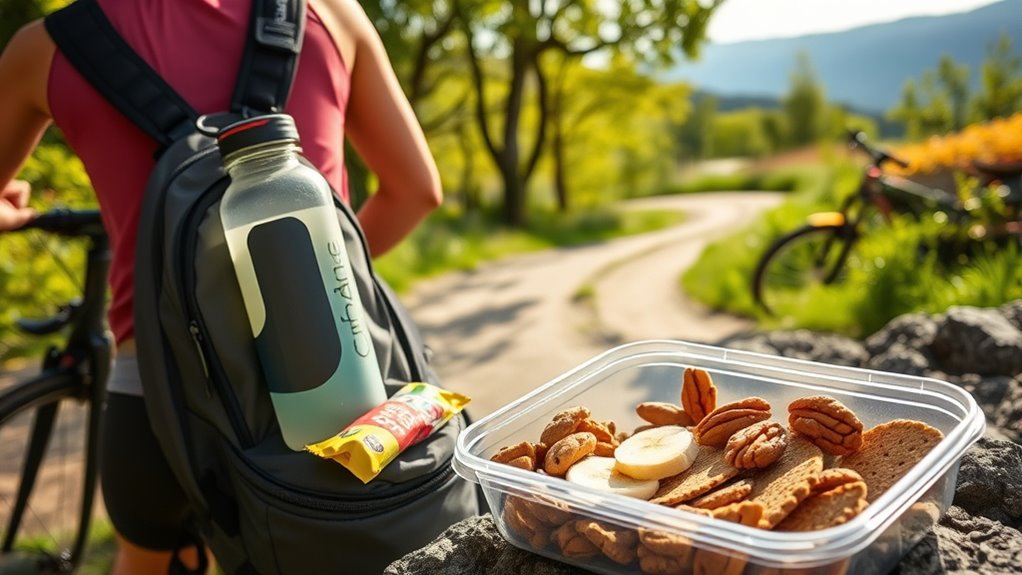
Choosing the right foods can make a significant difference in maintaining energy levels and speeding up recovery after long rides. Effective meal planning includes incorporating carbohydrate-rich options like whole grains, fruits, and vegetables to keep your energy steady. For example, incorporating performance kits from vehicle tuning analogies highlights the importance of optimized inputs for better results, similar to selecting the right fuel and nutrients for your body. Incorporating proper nutrition techniques can also help prevent gastrointestinal discomfort during intense activity. Consuming a variety of nutrient-dense foods ensures you receive essential vitamins and minerals necessary for overall health and performance. For quick energy boosts during rides, select snack options such as energy bars, dried fruits, nuts, or bananas. Including foods rich in fiber can aid digestion and reduce the risk of discomfort during activity. Post-ride, focus on protein and carbs to repair muscles and replenish glycogen stores—think yogurt with fruit or a turkey sandwich. Keep snacks portable and easy to digest, so you can consume them without hassle. Planning your meals and snacks ahead of time helps prevent fatigue and supports sustained performance.
Hydration Strategies to Complement Your Nutrition Plan
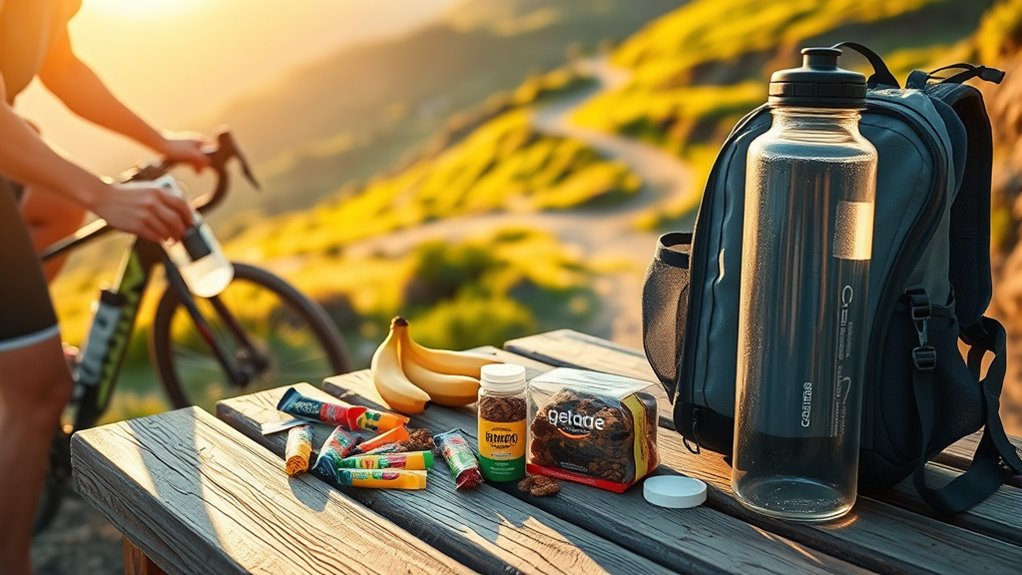
Proper hydration is essential to maximize your nutrition plan and maintain ideal performance on long rides. It helps preserve electrolyte balance and prevents dehydration, which can impair endurance. To stay well-hydrated, pay attention to hydration frequency, drinking small amounts regularly rather than large gulps infrequently. Consider your sweat rate and environmental conditions to adjust intake accordingly. Incorporate electrolyte drinks to replenish lost minerals such as sodium, potassium, and magnesium. Keep these tips in mind: – Drink every 15-20 minutes during activity – Use electrolyte-enhanced beverages for sustained balance – Monitor urine color as a hydration indicator – Supplement with water and electrolytes based on sweat loss – Avoid waiting until you’re thirsty to hydrate. Essential oils can also be used to support hydration and recovery by promoting relaxation and reducing muscle tension after rides. Regular filter maintenance of hydration equipment, such as water bottles and bladders, ensures cleanliness and prevents bacterial buildup. Additionally, being aware of hydration monitoring tools can help you track your fluid levels more accurately in real-time. Using AI-enhanced features in your gear can help optimize hydration strategies by providing real-time feedback on hydration levels. Staying aware of hydration strategies and maintaining proper fluid intake supports your nutrition plan and keeps energy levels steady.
Frequently Asked Questions
How Do I Adjust My Nutrition Plan for Different Weather Conditions?
When adjusting your nutrition plan for different weather conditions, focus on weather adaptation and temperature management.
In hot weather, hydrate frequently and include electrolyte-rich drinks to prevent dehydration.
In cold conditions, consume warm, calorie-dense foods to maintain energy and body heat.
Always listen to your body’s signals and modify your intake appropriately.
Proper nutrition tailored to weather guarantees you stay fueled, comfortable, and safe during your ride.
What Are Signs of Nutritional Deficiencies During Long Rides?
During long rides, you might notice signs of nutritional deficiencies like persistent fatigue and increased cravings for sweets. These symptoms indicate your body isn’t getting enough essential nutrients or energy.
Pay attention to these signs, and if they appear, consider adjusting your intake to include more balanced carbs, proteins, and electrolytes. Addressing these early helps maintain your performance and prevents more serious issues later in your ride.
Can I Rely Solely on Supplements Instead of Whole Foods?
Relying solely on supplements isn’t ideal, as they can’t fully substitute whole foods. Supplements are convenient for quick nutrients, but whole food alternatives offer essential vitamins, minerals, and fiber your body needs for sustained energy and recovery.
You should use supplements to complement, not replace, your diet. Incorporate balanced meals with fresh fruits, vegetables, and grains alongside supplements to ensure you’re fueling your ride effectively and maintaining overall health.
How Does Individual Metabolism Affect My Nutrition Needs?
Did you know that your metabolic rate can vary by up to 50% from person to person? This means your personalized nutrition needs differ considerably.
Your metabolism influences how efficiently you burn calories and absorb nutrients, impacting what and when you should eat during long rides.
Understanding your unique metabolic rate helps you tailor your diet, ensuring you get the right energy and nutrients to perform your best.
Are There Specific Foods to Avoid Before or During Long Rides?
You should avoid foods that trigger your food allergies or cause digestive issues before and during long rides. Steer clear of heavy, greasy, or spicy foods that can upset your stomach, and stay away from high-fiber snacks if you have digestion sensitivities.
Opt for easily digestible options like bananas or energy gels. By doing so, you minimize discomfort and keep your energy levels steady throughout your ride.
Conclusion
Just like a skilled alchemist, you can turn simple foods into your ride’s secret fuel. By understanding your needs, timing your intake, and staying hydrated, you’re crafting your own legend on two wheels. Remember, every ride is a quest—fuel wisely, hydrate well, and you’ll conquer miles with the resilience of a hero. Keep these tips in mind, and your long rides will become stories of endurance and triumph, written in every pedal stroke.
